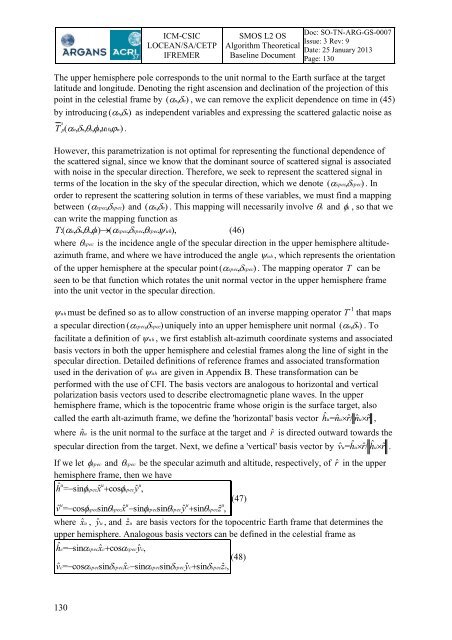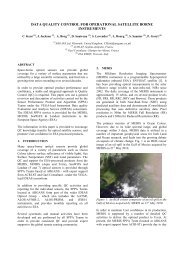SMOS L2 OS ATBD - ARGANS
SMOS L2 OS ATBD - ARGANS
SMOS L2 OS ATBD - ARGANS
Create successful ePaper yourself
Turn your PDF publications into a flip-book with our unique Google optimized e-Paper software.
130<br />
ICM-CSIC<br />
LOCEAN/SA/CETP<br />
IFREMER<br />
<strong>SM<strong>OS</strong></strong> <strong>L2</strong> <strong>OS</strong><br />
Algorithm Theoretical<br />
Baseline Document<br />
Doc: SO-TN-ARG-GS-0007<br />
Issue: 3 Rev: 9<br />
Date: 25 January 2013<br />
Page: 130<br />
The upper hemisphere pole corresponds to the unit normal to the Earth surface at the target<br />
latitude and longitude. Denoting the right ascension and declination of the projection of this<br />
point in the celestial frame by ( , nn)<br />
, we can remove the explicit dependence on time in (45)<br />
by introducing ( , nn)<br />
as independent variables and expressing the scattered galactic noise as<br />
s<br />
T p( n,<br />
n,<br />
s,<br />
s,<br />
u10,<br />
w)<br />
.<br />
However, this parametrization is not optimal for representing the functional dependence of<br />
the scattered signal, since we know that the dominant source of scattered signal is associated<br />
with noise in the specular direction. Therefore, we seek to represent the scattered signal in<br />
terms of the location in the sky of the specular direction, which we denote ( spec , spec)<br />
. In<br />
order to represent the scattering solution in terms of these variables, we must find a mapping<br />
between ( spec , spec)<br />
and ( , nn)<br />
. This mapping will necessarily involve s and s , so that we<br />
can write the mapping function as<br />
T: ( n, n,<br />
s,<br />
s)<br />
( spec,<br />
spec,<br />
spec,<br />
uh),<br />
(46)<br />
where spec is the incidence angle of the specular direction in the upper hemisphere altitudeazimuth<br />
frame, and where we have introduced the angle uh,<br />
which represents the orientation<br />
of the upper hemisphere at the specular point ( spec , spec)<br />
. The mapping operator T can be<br />
seen to be that function which rotates the unit normal vector in the upper hemisphere frame<br />
into the unit vector in the specular direction.<br />
uhmust be defined so as to allow construction of an inverse mapping operator T -1 that maps<br />
a specular direction ( spec , spec)<br />
uniquely into an upper hemisphere unit normal ( , nn)<br />
. To<br />
facilitate a definition of uh,<br />
we first establish alt-azimuth coordinate systems and associated<br />
basis vectors in both the upper hemisphere and celestial frames along the line of sight in the<br />
specular direction. Detailed definitions of reference frames and associated transformation<br />
used in the derivation of uh are given in Appendix B. These transformation can be<br />
performed with the use of CFI. The basis vectors are analogous to horizontal and vertical<br />
polarization basis vectors used to describe electromagnetic plane waves. In the upper<br />
hemisphere frame, which is the topocentric frame whose origin is the surface target, also<br />
called the earth alt-azimuth frame, we define the 'horizontal' basis vector hˆ u= nˆ<br />
u<br />
rˆ<br />
/ nˆ<br />
urˆ<br />
,<br />
where nˆ u is the unit normal to the surface at the target and rˆ is directed outward towards the<br />
specular direction from the target. Next, we define a 'vertical' basis vector by vˆ u= hˆ<br />
u<br />
rˆ<br />
/ hˆ<br />
urˆ<br />
.<br />
If we let spec and spec be the specular azimuth and altitude, respectively, of rˆ in the upper<br />
hemisphere frame, then we have<br />
ˆu<br />
u<br />
u<br />
h = sin<br />
specxˆ<br />
cos<br />
specyˆ<br />
,<br />
(47)<br />
u<br />
u<br />
u<br />
u<br />
vˆ<br />
= cos<br />
specsin<br />
specxˆ<br />
sin<br />
specsin<br />
specyˆ<br />
sin<br />
speczˆ<br />
,<br />
where xˆ u , yˆ u , and zˆ u are basis vectors for the topocentric Earth frame that determines the<br />
upper hemisphere. Analogous basis vectors can be defined in the celestial frame as<br />
hˆ<br />
c=<br />
sin<br />
specxˆ<br />
ccos<br />
specyˆ<br />
c,<br />
(48)<br />
vˆ<br />
c=<br />
cos<br />
specsin<br />
specxˆ<br />
csin<br />
specsin<br />
specyˆ<br />
csin<br />
speczˆ<br />
c,



